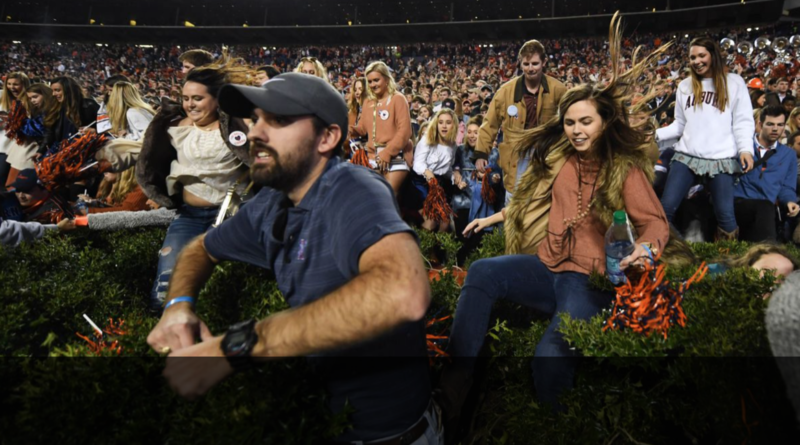Alan Truex: The Iron Bowl turned college football upside down

Remember when the College Football Playoff was going to ensure that the championship team would be one of America’s four best? There would be no more flukiness, no fly-by-nighter from Glacier National Park swooping in to take the grand prize, no unknown undefeated monster rising from the swamps of Central Florida.
No, we’d see only the traditional heavyweights in the semi-finals, and everything would be clearly defined.
So . . . now we see chaos as we look to the Playoff Committee to sort out a jumble. With the regular season over for most teams, as many as nine are said to be in the running for the final four. The permutations seem endless, so many possibilities that I don’t want to get started.
I’ll just say I like Clemson, a worthy defending champ, far as I can tell. It seems remarkable for the No. 1 team to lose its quarterback and best player (Deshaun Watson) and be in the playoff the following year. Clemson should stay on top by surviving the Miami Hurricanes in Saturday’s ACC Championship Game (ABC, 7 p.m. CST).
This is said with all due respect, of course, to Wisconsin, of the resurgent Big Ten, at 12-0 the only unbeaten team in the Power Five conferences.
We do know Auburn will be in the playoff if it wins Saturday’s Southeastern Conference Championship Game (CBS, 3 p.m. CST) in Atlanta. Not that this is a fair requirement. There will be a gaping home-field advantage for the University of Georgia which is 60 miles away.
Auburn’s coach Gus Malzahn finds himself defending the right of a flawed team at 10-2 performing on the biggest stage. He argues that Auburn is better now than it was when losing 14-6 to Clemson in September, “back then we were still trying to figure out our identity. We had a new quarterback (Saturday’s passing/running star, Jarrett Stidham), new coordinator (Chip Lindsey), and you saw us getting better and better.”
Actually, many of us did not notice. We were too narrowly focused on old familiar No. 1, Alabama, with the best recruiting class year after year and the most acclaimed coach, Nick Saban.
Sometimes America forgets Alabama’s most annoying rival, from the middle class of the Power Five. There’s no great glory in beating Auburn, which is why it’s so annoying. Auburn became Alabama’s season spoiler, as it often is, with its 26-14 triumph in Saturday’s Iron Bowl.
This is a series full of blocked kicks and fumbled snaps that tend to go Auburn’s way. A couple of botched center-snaps factored in Saturday’s upset, but the Tigers led in yards, first downs and minutes. And they had the best QB, in Stidham, refugee from scandal-ravaged Baylor.
By the way, I don’t know why they’re the Tigers and not the War Eagles, which they call themselves most of the time. After an Auburn win, their fans greet one another not with hello, but “War eagle.”
Why it’s called the Iron Bowl is another good question. The nickname is a reference to Birmingham, where the game was played for more than a century but not since 1998. By then, Birmingham was no longer a major global iron producer, that being an American industry in decline since the 1950s.
Whatever it’s called and wherever it’s played, Auburn-Alabama is one of college football’s most intense rivalries. Attending a few of these Iron Bowls, I always expected more fistfights – fueled by the omnipresent hip flask — than at the World’s Largest Cocktail Party, Georgia-Florida at Jacksonville.
In Saturday’s intrastate confrontation, Auburn was a 4 ½-point dog, though I hasten to mention that the upset was forecasted by Mark Roberson of this website, and he had history on his side. Since 2000, Auburn has won 10 Iron Bowls, ‘Bama 8.
Upon becoming head coach at Alabama in 2007, Saban did what he needed to do, which was end Auburn’s pesky domination. He’s won 7 Iron Bowls and lost 4.
The War Eagle Tigers were the Texas A&M of the SEC before the Aggies joined it. Auburn is the agriculture mecca of Alabama and not to be sneered at on the gridiron. Though its football tradition is forever overshadowed in Alabama by the immortal Bear Bryant, Malzahn’s Auburn won the national championship in 2011 and was runner-up in 2014.
Curiously, Malzahn was all but run out of the self-anointed “Loveliest Village on the Plains” after a 7-6 see-saw in 2015. The outcry against him was reprised last month when Auburn blew a 20-point lead against LSU, and the season record slipped to 5-2. When football is your life, 5-2 is not fulfilling.
It’s hardly surprising that Malzahn is not turning a deaf ear to Arkansas reaching out to him through his associates. He knows his value as one of college football’s most respected designers of run and pass schemes. Nobody makes better use of fast athletes.
Anyone who hires him must pay $7 million to buy out his contract, but that won’t deter well funded universities that appreciate football’s contributions to the mission of higher learning.
Georgia, 11-1, thinks of itself as a national championship contender, but the lone blemish is not easily overlooked: a 40-17 drubbing by Auburn earlier this month.
It’s difficult to imagine the title game of America’s most esteemed football conference being anticlimactic. Saturday’s SEC finale is the 122nd renewal of the Deep South’s Oldest Rivalry. But the dismantling of mighty Alabama, capped so cinematically by the plucking of hedges at Jordan-Hare, can leave a college football fan strangely disoriented, world turned upside down.
